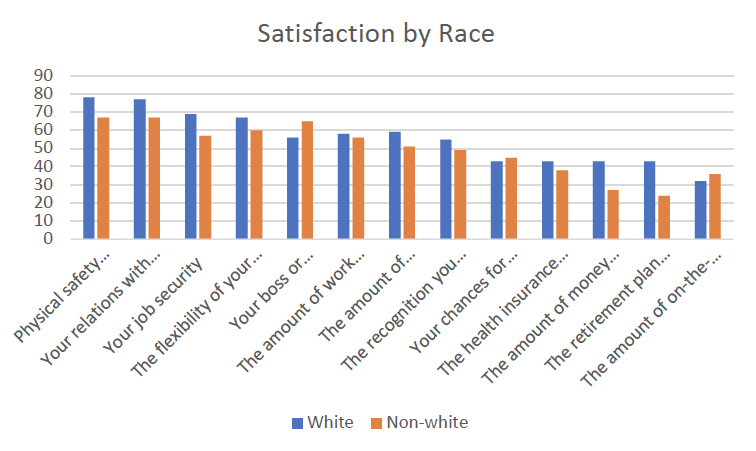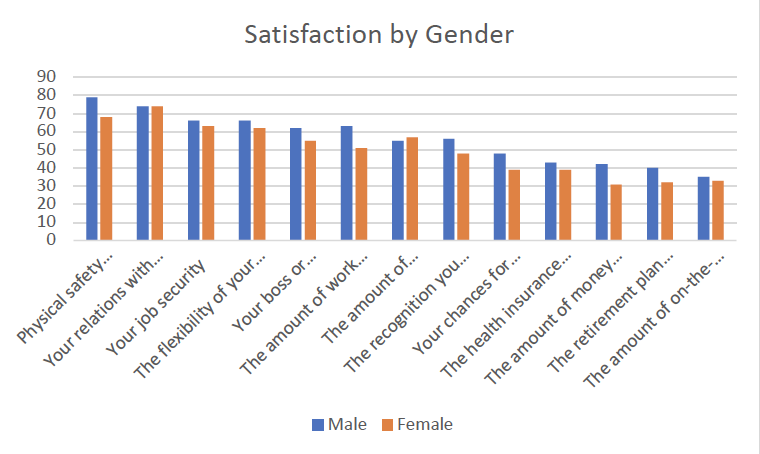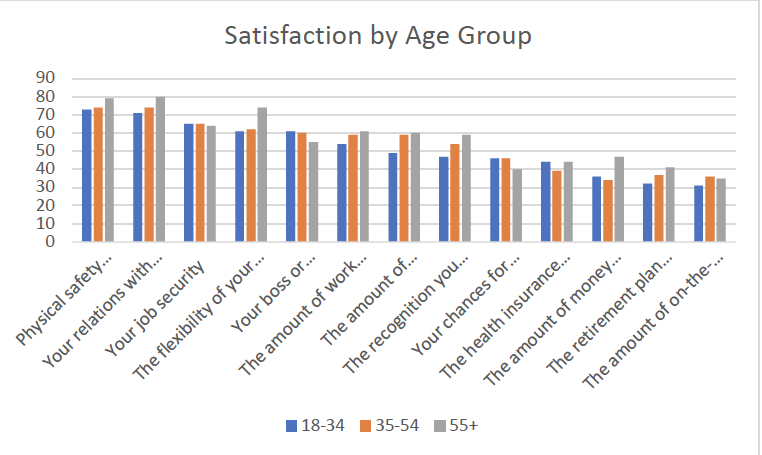
On October 4, 2019 Megan Brenan wrote an article outlining the latest results from a Gallop poll assessment measuring employee satisfaction on 13 job aspects, these were:
1. Your relations with coworkers
2. The physical safety conditions of your workplace
3. Your job security
4. The flexibility of your hours
5. Your boss or immediate supervisor
6. The amount of work that is required of you
7. The amount of vacation time you receive
8. The recognition you receive at work for your work accomplishments
9. Your chances for promotion
10. The health insurance benefits your employer offers
11. The amount of money you earn
12. The retirement-plan your employer offers
13. The amount of on-the-job stress in your job
As reported in her article, the majorities of US workers felt completely satisfied with 8 of the 13 aspects of their jobs. These were questions 1 – 8 above. However, she did report finding two demographics that varied; these were gender and full-time vs part-time employment.
Some demographic variables not included in her report, but of interest to those of us studying workforce retention needs, were found in a link to the original data provided in her report from Gallop (See original article). I therefore decided to compare the 13 job aspects by gender, race, and age. I have provided a bar graph of the results below.



Results
In Figure 1 the percent satisfaction between white vs non-white across the 13 job aspects reveals job satisfaction differences by race. When comparing the top 4 areas of satisfaction physical safety and relationship with coworkers both ranked number one and number two for each cohort at 78% and 67%, and 77% and 67%, respectively. While whites reported 69% satisfaction for job security, Non-whites ranked relationship with boss or immediate supervisor as third at 65%. Both whites and non-whites reported flexibility of hours as 4th at 67% and 60%, respectively.
Figure 2 compares the percent satisfaction by gender (see original article). The top four areas of satisfaction for females followed by percentages were: Relationship with co-workers (74%), physical safety conditions at work (68%), job security (63%), and 4th flexibility of hours (62%). While males only differed between ranks one and two. Males reported greater satisfaction with their physical safety at work (79%) followed by their relationship with co-workers as 2nd (74%). As with the females, males ranked job security as 3rd (66%) and flexibility of hours as 4th at 66%.
The Gallop Poll also separated the ages of the employees into three groups, 18-34, 35-54, and 55 years or older. In all but the 55+ age group, the top ranks of satisfaction were ranked 1 – 4 as follows: physical safety, relationship with co-workers, job security, and flexibility of hours, with a spread of only 0 – 3 percentage points between the two groups. Meanwhile the 55+ cohort ranked their relationship with co-workers as number one at 80%, followed by physical safety at work (79%). Ranking number 3 was flexibility of hours (74%) followed by job security (64%). One thing worth noting is the large spread between the younger age groups and the 55+ when it comes to flexibility in work hours. Those workers between the ages of 18-34 and 35-54 reported percentage satisfaction in this job area as 61 and 62% respectively. This is a difference of 12-13 percentage points between the generations.
Conclusion
This Gallop poll provides great insight and valuable information into the demographic differences in job satisfaction in the 13 job aspects listed above. GentraResearch’s goal is to take this type of data to the next level through conducting industry specific assessments on the needs of employees by job title and industry. Currently the construction industry, as well as others, are in critical need of workers. In order to recruit and more importantly retain these workers we must know what their needs are when it comes to engagement at the workplace by industry.
Read more from GentraResearch
- Latest Gallup Poll Reveals Employee Satisfaction Is Not Equal Across all Demographics
- From Critic to Coach: Develop Managers Who Give Great Feedback
- Construction adds few jobs in May as unemployment hits new low, openings reach peak
- Defining Generations: Baby Boomers, Generation X, Millennials, and Generation Z
- AGC Convention Summary • April 1 – 4, 2019